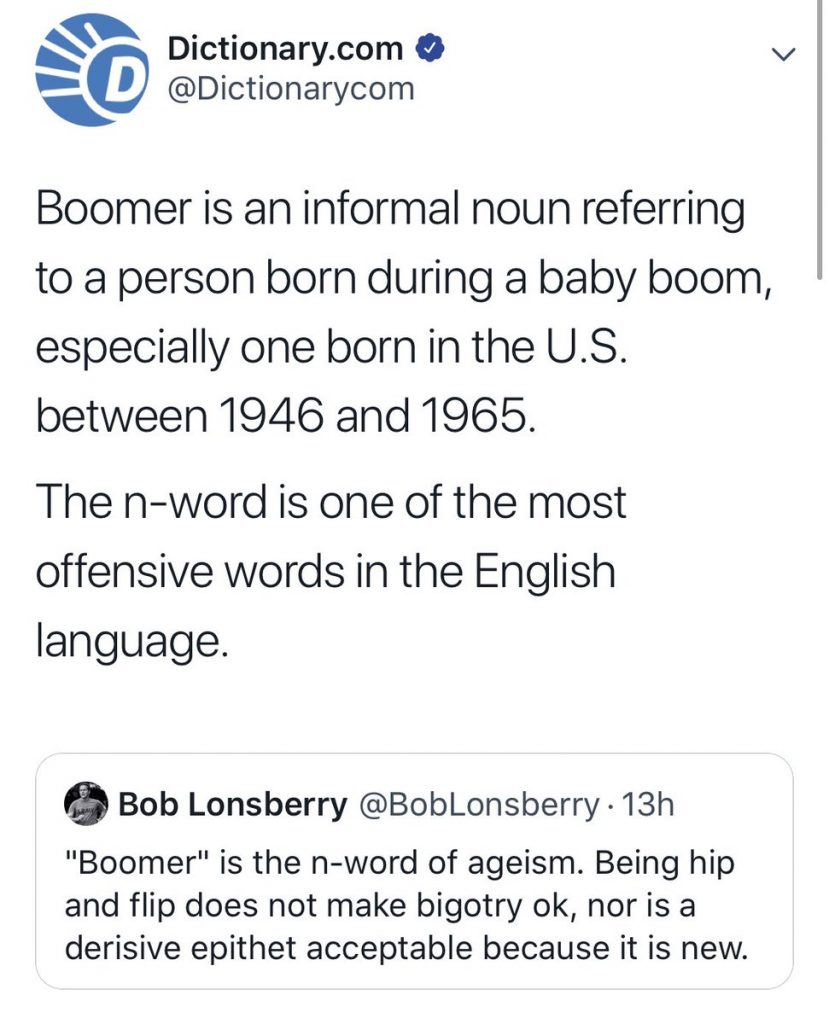In this post, I will be analysing the ‘ok boomer’ meme and its derivatives using Shifman’s framework. The term ‘meme’ was first introduced by Richard Dawkins (1976), defining it as a cultural unit of transmission or imitation, that is passed on in modified form by imitating or copying. However, there are more definitions and it is not settled which is the correct one. Blommaert & Varis (2015: 63) claim that ‘memes are signs, the formal features of which have been changed by users.’ Shifman (2013: 367) defines memes as ‘units of popular culture that are circulated, imitated, and transformed by individual Internet users, creating a shared cultural experience in the process.’ His framework, that I will be using to analyse the ‘ok boomer’ meme, is split into three main memetic dimensions, content, form and stance. It is not known where the phrase ‘ok boomer’ has its origins, but the first documented use comes from 4chan, then from reddit and later from twitter, where it gained the most of its popularity. In October 2019, an article reporting about the meme called ‘‘OK Boomer’ Marks the End of Friendly Generational Relations’ was published by The New York Times and since then, other media outlets published articles about this meme, for example Vox and Forbes. The derivatives I’ve chosen to analyse are ‘ok groomer’ and ‘ok zoomer’.

Content
The first dimension I will be analysing is content, which references ‘to both the ideas and the ideologies conveyed by it’ (Shifman 2013: 367). The meme ‘ok boomer’ is often used to disregard and make fun of opinions of older people (baby boomers), who are seen by the younger people as out-of-touch and close-minded because of their cultural differences and opinions of younger generation. The ‘ok zoomer’ meme refers to people born in Generation Z and their ‘woke’ opinions influenced by internet culture and fast upbringing and it is often used by boomers as a response to ‘ok boomer’. Both memes are used to mock a large group of people. The ‘ok groomer’ meme is different. It is also used to mock but unlike the previous memes, the mocking and disregard is directed to a specific online personality called Onision. Onision is a famous youtuber, who has now been exposed for grooming underage girls (hence the word ‘groomer’). This derivative gained its popularity on twitter and it is known only within the ‘Anti-Onision Community’ who call him out for his awful actions by using this meme. While ‘ok boomer’ and ‘ok zoomer’ are used to mock differences and opinions between generations, ‘ok groomer’ is used to mock and criticize Onision’s personality and past actions. The meme and its derivatives are perceived as offensive by the group or person they are directed at, as we can see in some articles and even tweets where ‘ok boomer’ is being compared to the n-word.

Radio host compared ‘boomer’ to the n-word and was corrected by the dictionary
Form
Form is the second dimension in this analysis, and it refers to ‘the physical incarnation of the message, perceived through our senses. It includes both visual/audible dimensions specific to certain texts, as well as more complex genre-related patterns organizing them’ (Shifman 2013: 367). The meme and its derivatives have a form of a phrase, but the derivative ‘ok zoomer’ originated on 4chan accompanied by a picture of a Wojak character, which depicts the typical looks of a zoomer and mocks them. The derivatives and the meme itself are often combined with other memes like doge or with pictures of celebrities and fictional characters. ‘Ok boomer’ spread in January 2019 when it was combined with doge and used as a mocking reply to a tweet. In June 2019, the phrase spread even more when a Twitter user @jedwill1999 made a song, where we can hear the meme in a spoken form, and ‘ok boomer’ is rapped on repeat. The spread continued on TikTok, where people lip-synced the song and joked about boomers. It was even used by a member of a New Zealand parliament to silence another member who interrupted her. The derivatives are related to the original because of their form and similar sound. Boomer, zoomer and groomer rhyme, have double o’s and end with ‘mer’ and only differentiate in the first letter.
Stance

The third dimension is called stance, and it’s used ‘to depict the ways in which addressers position themselves in relation to the text, its linguistic codes, the addressees, and other potential speakers.’ (Shifman 2013: 367). Stance is split into tree subdimensions: participation structures, keying and communicative function. The subdimension ‘participation structure’ tells us who are the participants in the meme and how are they participating. In the ‘ok boomer’ meme and its derivatives, the phrase is exchanged between two people. One person says it to the other. If the phrase is exchanged in a private conversation or a group chat, then the participants are the people in the chat or conversation. If it’s a tweet for example, then the participant is the creator of that tweet and the people who engage with that tweet. Keying is the overall style and tone of the communication. The ‘ok boomer’ meme is offensive to the person it’s directed at. The word ‘ok’ does not mean agreement in this phrase, but it’s meant sarcastically. The derivatives have the same tone and style. Phatic function and conative function are the main communicative functions of this meme and its derivatives. Phatic function is a function that establishes, prolongs or discontinues conversation. When ‘ok boomer’ is used as a reaction to a tweet or a response, it’s meant to dismiss the opinion of the other person and end the conversation. Conative function is used to get a person to do something or to not do something. In this case, by using ‘ok boomer’ we want the other person to change their opinion.
In conclusion, I find the Shifman’s framework to be useful for a better understanding of a meme. By analysing ‘ok boomer’ I have learned how were its derivatives created and why. ‘Ok zoomer’ has been created as a reaction to its original. I enjoyed working on this analysis, because meme culture has been a big part of my life and looking at it from a perspective of an analysis is quite interesting.
References
Blommaert, J., & Varis, P. (2015) ‘Conviviality and collectives on social media: Virality, memes and new social structures’. In Tilburg Papers in Culture Studies 139: Enoughness, accent and light communities: Essays on contemporary identities. Tilburg: Tilburg University, 58-72.
Dawkins, R. (1976). The selfish gene. Oxford, England: Oxford University Press.
Shifman, L. (2013). ‘Memes in a digital world: Reconciling with a conceptual troublemaker’. Journal of Computer-Mediated Communication, 18(3), 362-377.


